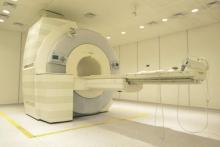Current recommendations for identifying sacroiliitis on MRI to classify patients with nonradiographic axial spondyloarthritis should still depend on the presence of subchondral bone marrow edema, but additional evidence of structural lesions can be taken into account to define the presence of inflammatory lesions, according to a consensus review by experts from the Assessment in SpondyloArthritis International Society MRI working group.
The additional information provided by structural lesions, such as erosions, detected via MRI of the sacroiliac (SI) joint or spine is not necessary for the definition, but “may enhance confidence in the classification of axial SpA [spondyloarthritis],” said the panel of 16 rheumatologists, 4 radiologists, and 1 research fellow, who presented their summary and draft proposal at the January 2014 annual assembly of the Assessment in SpondyloArthritis International Society (ASAS), where members unanimously approved it (Ann Rheum Dis. 2016 Jan 14. doi: 10.1136/annrheumdis-2015-208642).
The group’s goal was to examine whether new data published on axial SpA in the 5 years following the 2009 publication of the ASAS recommendations were “sufficient to merit a change in the MRI definition of a positive MRI and clarify any misunderstanding of the existing definition.”
Overall, the working group determined that the addition of “structural damage changes of the SI joints and the addition of features on MRI of the spine for classification purposes is not yet clear and this continues to be an important research agenda.”
Adding any single lesion or combination of lesions to the current classification criteria for nonradiographic axial spondyloarthritis (nr-axSpA) did not increase the sensitivity of the MRI definition without losing specificity in one cohort, whereas there was an unclear benefit to adding SI erosion to the definition in another cohort. The evaluation of these lesions on MRI depended on the use of T1 weighting and fat-suppression techniques, as well as the contextual interpretation of MRI, which currently add too much complexity to the definition of a positive SI joint MRI to be useful in achieving a “consensus for definitions for each MRI structural damage lesion and the setting of thresholds for any defined lesion or combination of lesions,” the working group wrote.
The panelists found that there was no consistent beneficial effect of adding features of SpA on spine MRI to the definition. Spine MRI added incremental sensitivity in other analyses, but also increased false-positive SpA diagnoses.
In a commentary reviewing the controversy and evidence for classifying diseases within the spectrum of axial SpA, Dr. Atul Deodhar of Oregon Health and Science University, Portland, and his colleagues noted that “there is no need to differentiate between a diagnosis of nr-axSpA and that of [ankylosing spondylitis] in clinical practice, since the only purpose for having these two labels is classification.” They said the need for formal distinction between nr-axSpA and ankylosing spondylitis may require some exceptions, such as when it is necessary “to specify an approved indication for TNFi [tumor necrosis factor inhibitor] therapy, when off-label use of biologics must be avoided ... and to clarify the presence of structural changes that are required for patients to receive coverage from their insurance carrier to use a TNFi” (Ann. Rheum Dis. 2016 Jan 14. doi: 10.1136/annrheumdis-2015-208852).
The working panel and commentary authors declared having no competing interests.


